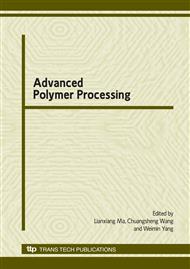p.357
p.363
p.369
p.375
p.381
p.387
p.393
p.398
p.405
Research on Microchannel of PMMA Microfluidic Chip under Various Injection Molding Parameters
Abstract:
Microfluidic chip has bright application prospect in the field of chemical and biological analysis. PMMA is the best material for microfluidic chip fabrication because of its low cost, prominent electrochemical properties and biological compatibility. In this work, a triple-channel microfluidic chip was designed; a nickel mold insert with microstructure was fabricated by UV-LIGA technology, and then the injection mold was designed and fabricated. The change in cross-section dimensions of microchannel was chosen as evaluating indicator, and micro-injection molding experiments were carried out. Then the influence of process parameters on cross-section dimensions of microchannel was observed with microscope. Experiment results demonstrated that substrate and cover plate could be manufactured in a single injection molding process by "1+1" type mold, and the manufacturing cycle was reduced to less than 20s, so production efficiency was greatly enhanced. Best combination of process parameters was obtained when mold temperature was 80°C, melt temperature was 250°C and injection rate was 297mm/s. Thereby, high quality substrate and cover plate could be manufactured efficiently.
Info:
Periodical:
Pages:
381-386
Citation:
Online since:
December 2009
Authors:
Price:
Сopyright:
© 2010 Trans Tech Publications Ltd. All Rights Reserved
Share:
Citation:


